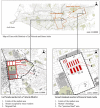Street vendors in Lima in the time of COVID-19: Guilty or oppressed?
- PMID: 34898683
- PMCID: PMC8653373
- DOI: 10.1111/cag.12712
Street vendors in Lima in the time of COVID-19: Guilty or oppressed?
Abstract
The debate over the formality and informality of street vendors in Lima (Peru) is a long lasting one that has resulted in significant conflicts between the authorities and the vendors, wherein the latter are often represented as victims or people unable to comply with any type of rule. During the COVID-19 lockdown period, the urban markets in Lima have had to abide by new safety and hygiene measures and follow new social norms to protect both vendors and buyers. This paper focuses on two food markets in the city (La Parada and Santa Anita), describing and analyzing different implementations, interpretations, and representations of the lockdown rules. The main objective is to broaden the understanding of the different types of street vendors who work in Lima and contribute to the de-homogenization of the phenomenon. The study is based on interviews, ethnographic observations, and digital ethnography.
Le débat sur le statut formel ou non des vendeurs de rue à Lima au Pérou est un débat de longue date qui a donné lieu à d'importants conflits entre les autorités et les vendeurs, ces derniers étant souvent représentés soit comme des victimes, soit comme des acteurs incapables de se conformer à une quelconque règle. Pendant la période de fermeture en raison de la pandémie de COVID‐19, les marchés urbains de Lima ont dû respecter de nouvelles mesures de sécurité et d'hygiène et suivre de nouvelles normes sociales pour protéger à la fois les vendeurs et les acheteurs. Cet article se concentre sur deux marchés alimentaires de la ville (La Parada et Santa Anita), décrivant et analysant les différentes formes d'application, d'interprétation et de représentation des règles de fermeture. L'objectif principal de l'étude est d'élargir la compréhension des différents types de vendeurs de rue qui travaillent à Lima et de contribuer à l'émergence d'une vision moins réductrice de ce phénomène complexe. La démarche est basée sur des entretiens, des observations ethnographiques et une ethnographie numérique.
Keywords: COVID‐19; Lima; informal economy; politics of difference; street vendors.
© 2021 The Authors. The Canadian Geographer / Le Géographe canadien published by Wiley Periodicals LLC on behalf of Canadian Association of Geographers / l'Association canadienne des géographes.
Figures
References
-
- Adama, O. 2020. Criminalizing informal workers: The case of street vendors in Abuja, Nigeria. Journal of Asian and African Studies. 10.1177/0021909620930740 - DOI
-
- Appadurai, A. 1996. Modernity at large: Cultural dimensions of globalization. Minneapolis, MN: University of Minnesota Press.
-
- Benson, M. 2012. How culturally significant imaginings are translated into lifestyle migration. Journal of Ethnic and Migration Studies 38(10): 1681–1696.
-
- Berroir, S. , Bouloc C., Cattan N., Fleury A., Frétigny J. B., and Lassaube U.. 2016. La tour Eiffel dans la poche. Informalité et pouvoir dans la construction de la métropole touristique. L'Espace Politique 29(2): 1–22.
-
- Caliandro, A. 2016. Ethnography in digital spaces: Ethnography of virtual worlds, netnography, and digital ethnography. In Handbook of anthropology in business, ed. Denny R. M. and Sunderland P. L.. New York, NY: Routledge, 1–39.
LinkOut - more resources
Full Text Sources

